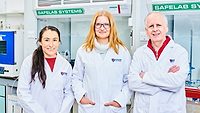Purdue University Researchers Formulate Bio-based Glues

Patent-pending adhesive formulations developed at Purdue University from fully sustainable, bio-based components establish bonds that grow stronger when underwater or exposed to wet conditions.
Gudrun Schmidt, an associate professor of practice in Purdue’s Department of Chemistry, and a team of researchers, developed the formulations from zein, a protein found in corn and tannic acid. A paper about the team’s research was published in the peer-reviewed journal ACS Applied Materials & Interfaces.
The adhesive formulations could be further developed and used in the restoration of coral reefs and have applications in the construction, manufacturing, biomedical, dental, food and cosmetic industries.
Schmidt and her colleagues conducted underwater adhesive experiments on their formulations, using different surfaces and different waters, including seawater, saline solution, tap water, and deionized water.
“Interestingly, the water type does not influence performance a great deal, but the substrate type does,” said Schmidt. “An additional unexpected result was bond strengths increasing over time when exposed to water, contradicting general experiments of working with traditional, petroleum-based glues. Initial adhesion underwater was stronger compared to benchtop adhesion, suggesting that water helps to make the glue stick underwater.” Protective skin formed on the surface of the adhesives when placed underwater, which kept water from entering the rest of the material immediately. “But once the skin was in place, it could be broken to induce faster bond formation.”
“We can use inexpensive, sustainably sourced, plant-based materials to make gallons of glue within hours. The adhesives are very simple to make in the lab or outdoors, everywhere on the planet.” According to Schmidt, other researchers are formulating adhesives that mimic the glues used by mussels, barnacles, oysters, and sandcastle worms to adhere to the seafloor and other wet surfaces. Those best-performing formulations, however, are fully synthetic.
“Lengthy syntheses with the use of harsh chemicals may hold back their future development. Nontoxicity, sustainably sourced materials, and minimal environmental impact are increasingly in demand. Consequently, several groups have turned to developing new and remaking old adhesive systems using bioinspired or bio-based chemistry.”
An additional application for the patent-pending Purdue-developed adhesive formulations is the restoration of coral reefs. “There are several major efforts, worldwide, planting young corals to replace those structures that are already dead,” said Schmidt. “A major hindrance to these efforts is lack of suitable underwater adhesives that work well for this application.” Schmidt and her research team are working with the Coral Restoration Foundation, sending various formulations to be tested. “We recently visited the Florida Keys to test a few formulations in bucketsful of ocean water, it is great to see our work outside of the research lab and in the real, wet world.”
The Coral Restoration Foundation (CRF) searches for the most efficient and effective method of outplanting coral onto reef sites. Phanor H. Montoya-Maya, coral restoration program manager at CRF, said, “Having different alternatives means different species and habitats can be outplanted with positive results. Science collaborations like this allow us to test and fine-tune methods before mainstream restoration. Field preliminary results are very encouraging, and we'll continue to provide feedback to Purdue researchers to ensure the final product is consistently successful across multiple restoration goals.”
To learn more, visit www.purdue.edu/president/strategic-initiatives.com.
Looking for a reprint of this article?
From high-res PDFs to custom plaques, order your copy today!





